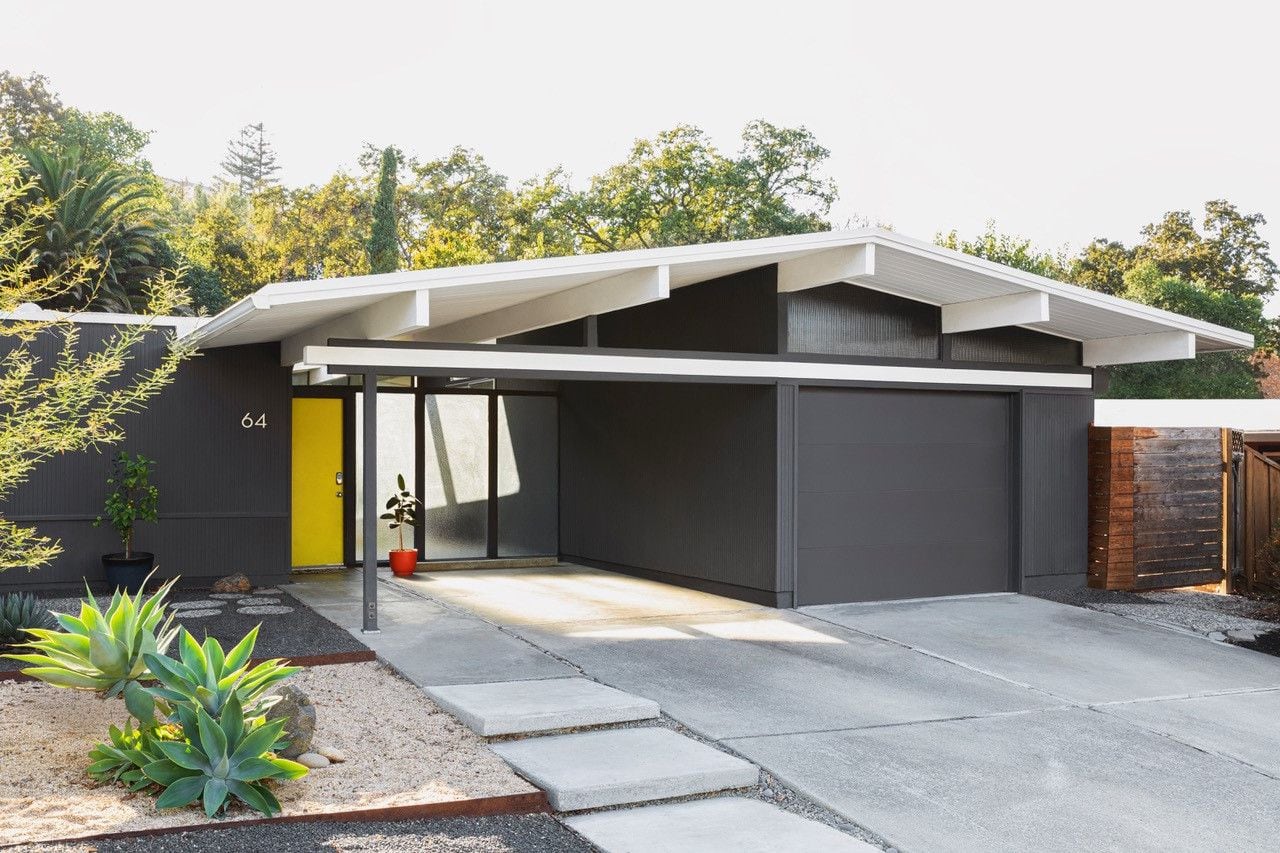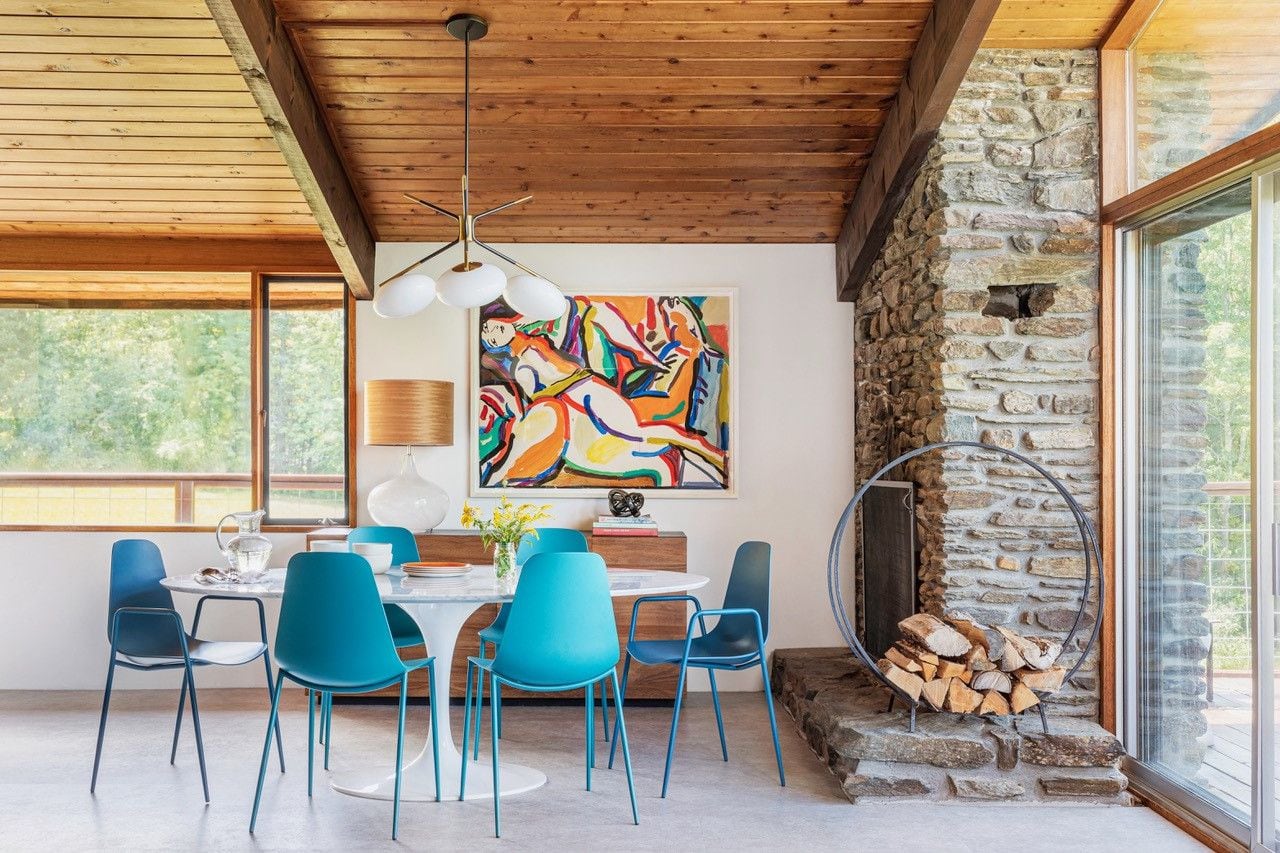Midcentury modern houses and their easy indoor-outdoor living revolutionized the way people dwell, especially on the West Coast. The “Mad Men”-era architecture is most associated with great rooms under vaulted ceilings, accent colors as vibrant as Marilyn Monroe’s gowns and Sputnik satellite-inspired light fixtures reflecting the effervescent Space Age. From cocktail bar carts to backyard patio parties, and glass doors that slide away boundaries, the feeling is expansive, the hi-fi vibe fun-filled.
The style propagated 70 years ago by tract developers Joseph Eichler in California and Robert Rummer in Oregon continues to influence new construction, according to experts in real estate and the editors of Architectural Digest. Rummer-built homes are rarely on the market and sell for over asking price. Many owners stay put for decades, refusing to give up a glass-enclosed central atrium, towering transparent walls and skylights that spotlight nature on sunny or wet, gray days.
The “spirit and sleekness” of midcentury modern design can uplift any space, says designer Karen Nepacena, who will be in Portland on Dec. 10 talking about ideas in her new book, “Midcentury Modern Style: An Approachable Guide to Inspired Rooms” ($35, Gibbs Smith). With images by Portland photographer Christopher Dibble on all 216 pages, the book beautifully shows how to achieve the desirable swank style on a budget.
Nepacena’s suggestions come from her hands-on experience restoring her Northern California house built by Eichler. She and her husband, John Shum, chronicled their progress in their online journal Destination Eichler, which grew to become a full-service interior design firm.
Her approach to midcentury modern, or MCM: “Mixing in MCM-inspired colors, patterns, textures and treasured objects can take a space from just a room with four walls to an environment that evokes comfort and joy.”
She offers solid advice on positioning furniture to best navigate a floor plan as well as smart ways to create different moods, from “relax and recharge” bedrooms to efficient, inspiring work spaces.
She also explains the endearing qualities of post-and-beam midcentury homes that relied on readily available wood to cover floors, walls and sometimes ceilings. Brick, stone and exposed aggregate concrete also drew the outdoors inside. Buoyant organic shapes like ovals and circles showed up in furnishings, their spare designs making ornate classic furniture look fussy and old-fashioned.
“Midcentury modern sofas ... have clean, modern lines, simple tapered legs (wood or metal) and straight arms,” Nepacena writes. Dibble’s photos show coffee tables in a surfboard form and Japanese American artist and industrial designer Isamu Noguchi’s 1947 glass-top table brilliantly supported by two identical curved wood pieces, one upside down.
Displays of mod color palettes include primary red, blue and yellow to pastel light pink, pale yellow, baby blue and sea green as well as 1970s natural shades of turquoise, chartreuse, orange and brown.
Nepacena finds artwork at estate sales, antiques markets and garage sales, and the book lists recommended retailers, artists, designers and manufacturers such as Oregon-founded Ann Sacks tile, Rejuvenation light fixtures and hardware and Schoolhouse lighting and lifestyle goods.
The mother of two has tried-and-true tips for kid’s bedrooms, such as resilient fabrics and washable rugs, and ways to maximize space with bunkbeds and shelves. In every room, she achieves minimalism by using multipurpose furniture and clever storage solutions.
Many pages are devoted to creating a functional, practical and pretty kitchen. She offers advice on big-ticket items like cabinets, counters and backsplashes and less expensive upgrades like replacing drawer pulls with midcentury-inspired bowties, half-moons or mushroom knobs. Brass and polished chrome finishes are period-appropriate choices, she says.
Handcrafted ceramics can be displayed on shelves. “Try a set of orange coffee mugs or some speckled robin’s-egg-blue bowls, details reminiscent of original midcentury design,” she writes. “Bring in kid-friendly melamine dishware in midcentury-inspired colors or graphic patterns.”
She says many modern-day tableware lines are modeled after midcentury introductions from Catherine Holm, Fiestaware, Heath Ceramics and Krenit. Not surprisingly, Pyrex’s 1956 pink daisy, 1957 butterprint and 1983 colonial mist bowls are collectibles.
A low-stakes start to inserting midcentury modern in a home could be a boomerang-patterned shower curtain or an Eames Hang-It-All coatrack. Outside, install house address numbers in a sans-serif font and era-evoking globe or sconce lighting.
Meet Karen Nepacena and photographer Christopher Dibble, from 2 to 5 p.m. on Sunday, Dec. 10, at City Home showroom at 1101 S.E. Third Ave. in Portland. Oregon Home magazine editor Emily Grosvenor, who wrote “Find Yourself at Home A Conscious Approach to Shaping Your Space and Your Life,” will facilitate a conversation followed by an audience question-and answer period. RSVP to get free tickets at eventbrite.com/e/exclusive-book-signing-at-city-home-midcentury-modern-style-tickets-714825070027.
For more inspiration, Dibble has a series of giclee prints of his photographs of iconic midcentury furnishings. Included in the “Midcentury Objectified” series is J.A. Bauer Pottery’s 1940s “ringed” ceramic Beehive Batter Bowl and Finnish American designer and architect Eero Saarinen’s 1948 Womb Chair, which was contoured to make a person feel comfortable and secure.
From 10 a.m. to noon Dec. 15, Christopher Dibble will sign copies of “Midcentury Modern Style: An Approachable Guide to Inspired Rooms” at Assemblage’s Makers Fair Holiday Market held adjacent to the Rejuvenation showroom at 1100 S.E. Grand Ave. in Portland (reserve a seat at the book event at eventbrite.com). The Makers Fair Holiday Market is free to see and open from 10 a.m. to 6 p.m. Monday-Saturday and 11 a.m. to 5 p.m. Sunday through Dec. 23. Dibble co-founded Assemblage, a makers collective launched in 2020 to help small businesses after craft markets closed during the pandemic.
— Janet Eastman | 503-294-4072
jeastman@oregonian.com | @janeteastman

